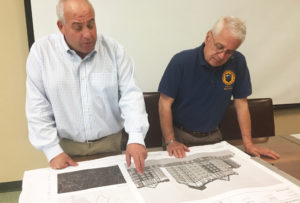
Construction is underway at The Club at Briarcliff Manor, a $168 million senior living community for up to 550 residents on the historic site of the former Briarcliff Lodge resort hotel and King”™s College.
Chicago-based Senior Lifestyle Corp. is developing the 385-unit facility on the property at 150 Lodge Road. The community will include 325 independent living rental units for seniors, 37 villas and 60 units in a supported living center.
With a model homes center already open on the property, the first phase of residential construction began this spring on the western side of the 59-acre site. Labeled the upper village, it includes two interconnected eight-story and seven-story Tudor-style buildings whose architecture will evoke the original Briarcliff Lodge on the property. The buildings will house 168 independent living, 119 assisted living and 32 memory care apartments, many with views of the Hudson River.
A 1,500-square-foot lodge room will be open for village use. Other amenities for residents will include a library, creative arts studio, theater, salon, physical therapy gym, visiting physician office and fitness center.
As a condition for municipal approval of the project, the developer has built an eight-acre playing field and parking lot for the village, a comfort station and a pump station near the site.
The Club is expected to open to residents in the summer of 2019, said Nancy Cutter, vice president of development at Senior Lifestyle. Monthly rents will range from $6,000 to $12,000, depending on the unit”™s location in the community, care and services and apartment size.
Plans for the site to be converted into some form of senior residence community date to 1999, said Briarcliff Manor Village Manager Philip E. Zegarelli.
Most recently, Integrated Development Group, a suburban Chicago-based company that purchased the Briarcliff Manor property for $32 million in mid-2009, planned to develop a fee-for-service continuing care retirement community on the site. Continuing care communities are residential options that offer an independent living unit, amenities and access to health care services under a single contract.
Although Integrated Development broke ground on the $350 project in 2013, a number of factors delayed progress, including a shift in the housing market landscape.
According to Zegarelli, continuing care communities are traditionally made up largely of condominiums, which became a less favorable development option, and less likely to receive lender financing, compared with rental units. “The project got caught in an economic time warp,” he said. “It morphed into a different type of economic cash flow model.”
Despite the change in the type of housing offered, Zegarelli said the building”™s footprint is “virtually the same” as the previous project.
Integrated Development merged with Senior Lifestyle in 2013, Cutter said. Both Cutter, who formerly served in a similar role at Integrated Development, and that company”™s founder, Matthew K. Phillips, joined Senior Lifestyle following the merger.
“There’s a handful of people who have been on this project for years and who are seeing it through to its conclusion,” said Zegarelli.
Since Senior Lifestyle began work at the site in April, including soil removal and rock blasting, Zegarelli said village residents have started to ask questions about the project.
To keep residents informed, representatives from Senior Lifestyle will attend the village Board of Trustees meeting on June 7 to answer any questions or concerns.
“It’s all according to the original plans that were approved,” Zegarelli said of the redevelopment of the historic property. “Now it’s just coming to fruition.”






















